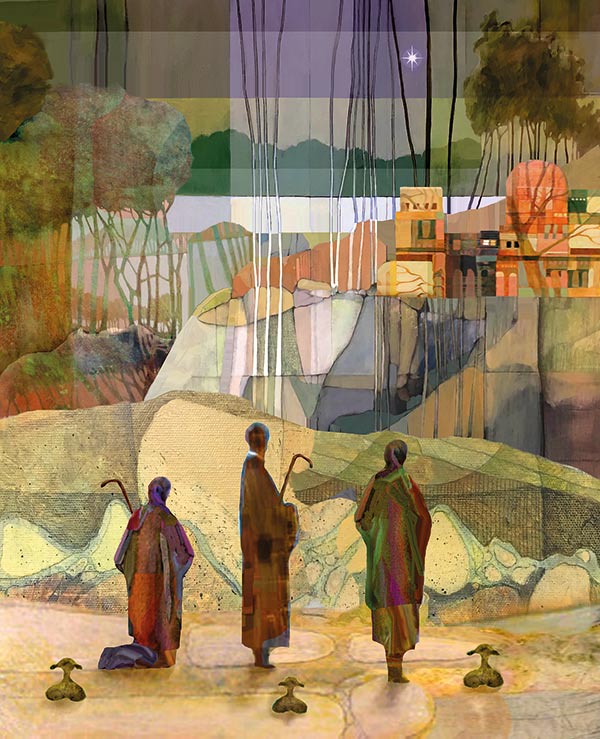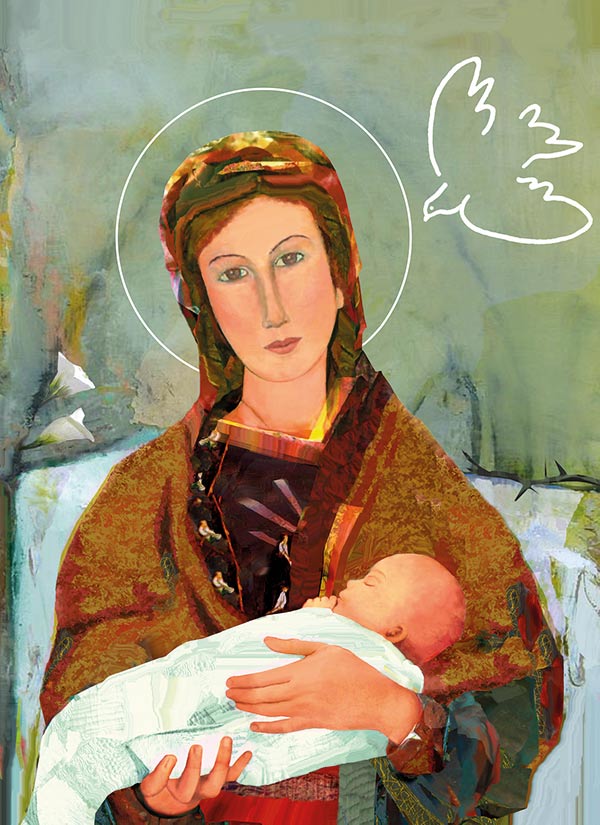Subtotal: $
Checkout-

Portraits of Survival
-

Hunger
-

Three Pillars of Education
-

The Joy of Mending Jeans
-

Zero Episcopalians
-

Making Art to Mend Culture
-

Repairing Relationships
-

Not Everything Can Be Fixed
-

Architecture for Humans
-

Yielding to God
-

Salvaging Beauty from the Ruins
-

On Motherhood and Climate Change
-

An Octopus, a Septuagenarian, and a Millennial
-

Ifs Eternally
-

Poem: “Andy Mayhew, Author of the Sonnets of Shakespeare”
-

Poem: “Daedalus”
-

Letters from Readers
-

My Liberal Arts Education in Prison
-

One Parish One Prisoner
-

What’s a Repair Café?
-

Analog Hero
-

The Sacred Sounds of Hildegard of Bingen
-

Covering the Cover: Repair
-

Could I Do That?
-

Who Can Repair the World?
-

Rebuilding Notre-Dame Cathedral
-

Why Serve?
-

In Praise of Repair Culture
-

Just Your Handyman
-

To Mend a Farm
-

The Home You Carry with You

Heaven Meets Earth
In the birth of Christ, God comes to restore and set free every person and all creation.
By Rowan Williams
December 8, 2023
Available languages: Español
Next Article:
Explore Other Articles:
One of the prayers we hear at carol services reminds us that Christ’s incarnation “brings into one things earthly and things heavenly.” It is an insight deeply rooted in Christian tradition. Already in the second Christian century people were talking about the events of Christ’s life, death, and resurrection as a “recapitulation,” a summing-up of the entire human story. And the New Testament language in Romans 8 and Colossians 1 about how the reality of Christ affects the entire cosmos continued to resonate through the entire early Christian period. What happens when God becomes human is not simply an emergency plan to tidy up the forgiveness of our sins, but a matter of releasing us to be what we were made to be.
This movement into what we are meant to be involves recognizing that we exist in a complex network for the sharing of life, an immeasurable symphony of patterns of activity, each activating and enlarging every other. The basic form of the sin from which we need to be delivered is the myth of self-sufficiency. The diabolical urge that destroys our well-being again and again is the temptation to think of ourselves as somehow able to set our own agenda in isolation, and the greatest and most toxic paradox that results is that we become isolated from our own selves. We don’t and can’t know what we are as participants in the symphonic whole, and so we block off or screen out the life we need to receive, refusing to share the life we need to give. We live shrunken, hectic, short-term lives, stuck in futile conflicts and vacuous rivalries. We refine our skill at identifying other human lives, as well as the entire nonhuman environment, as competitors for space, forces that will, left to themselves, diminish rather than enrich us. We need to be healed from this habitual screening-out.

Michael Torevell, News of Great Joy, mixed media and digital painting, 2022. All artwork used by permission.
This means that the “repair” involved in Christ’s coming in flesh is a repair of our relation to ourselves. Saint Augustine memorably said that our problem is that we are away from home; we are never properly “inhabiting” ourselves, living in our actual bodies and memories. Christ comes to introduce us to the self we have not met – the unique responsive spark that springs up out of the recognition that we emerge as gifts from the hand of God, that we are made alive only as part of the symphonic flow of all things working together, that our fullest “actualization” is to stand in and before the divine mystery saying “Abba” in the spirit of Jesus. The gift of the Spirit is something that makes us see where and how we are fed, the depth at which we are always receiving, being given birth. It entails seeing the persons and things around us as bearers of life – whether they look like friends or enemies at first sight.
The particular perspective offered by the story of Christ’s birth is the one that so many traditional seasonal hymns underline: the unlimited eternal activity that is God unveils itself in the form of the most dependent kind of humanity we can think of. To be “godlike,” then, is not to be in control or “on top of” everything. The most passive and vulnerable reality is transparent to God, the most forgotten and despised human presence is not abandoned by the Redeemer who is not ashamed to be fed by what God has made, by the warmth and the shelter and the milk of a human body. The moment of Christ’s birth is already bound up with the mystery at the end of Jesus’ earthly ministry – that God is most sovereignly active when the humanity that has been fully and uniquely united with the creative Word is nailed to the cross and can’t move, when God is incarnate in a dying body, and then a dead body.
The incarnation of the Word of God opens up the central reality of what we are in God’s hands. It repairs that great disease of the imagination that prompts us to fantasize about being free from the body and the passage of time, free from the constraints of what we have made of ourselves, from our promises and mutual obligation, from our sheer neediness. It is this disease of the imagination that makes us fear and despise strangers – and all the strangenesses of the world we are part of, and, not least, the stranger living within our own heart.
Christ comes to introduce us to the self we have not met – the unique responsive spark that springs up out of the recognition that we emerge as gifts from the hand of God.
Without knowing ourselves in this way, we remain strangers to ourselves – and that means that we shall end up finding our own selves to be our enemy. Isn’t this often what we mean by “hell”? Not a set of arbitrary punishments from outside but the bare fact of not being able to be at peace with what we are, struggling to establish ourselves on the foundation of our own resourcefulness and strength of will. The awful unreality of this is famously laid out in Milton’s Paradise Lost: the fallen angels resolve, more or less knowingly (which is what makes it so grim a picture), to opt for untruth. That basic untruthfulness has the effect of shrinking our humanity more and more inexorably until there is almost nothing left for God to work with. We can and should pray that no being will be finally stuck in that unreality; but we are fools not to face the scale of the danger for our unmoored and chaotic minds and hearts.
The great evening hymn of Bishop Thomas Ken prays “That with the world, myself and Thee, / I, ere I sleep, at peace may be.” These words express beautifully all the levels of reconnection that we need to acknowledge. To see God in the dependent child in the cradle and at the breast, and to say, like Pilate to the crowds in Jerusalem, “Behold the Man,” is to recognize that authentic humanity is not afraid of weakness. This is the beginning of our ability to recognize the dignity and the promise of what looks weak and insignificant in the world around us. As we look afresh in this way, we open the doors to peace with the world: not a passive and static balance but a peace that is the active exchange of life.
And we are at peace with God. In what must be one of the oddest ideas in religious history, we come to grasp – just a bit – the extraordinary fact that for us to be in the image of God, growing up into the fullness of love and freedom and joy for which we were created, means “growing into the cradle”; being born again, as they say, not as a moment of religious consolidation but in a new beginning of grateful dependence and the acknowledgment of a hunger for the real that will be both satisfied and stimulated afresh by the constant gift of God wherever we turn. Our sin-obscured selves are repaired as we are built again into our created place and, out of that, are given the freedom to be, in our own ways and at our own level, “creators,” beings through whom the one Creator transmits life and promise. The exchange of spiritual gifts that Saint Paul so wonderfully describes in the life of the Christian community is just the tip of the iceberg, a fragment of the reality in which the entire creation lives.

Michael Torevell, Ave Maria, mixed media and digital painting, 2021.
Uniting things earthly and things heavenly: Christ’s life, death, and resurrection have the effect of clearing our inner imaginative space, freeing us from the myths in which we have imprisoned ourselves, enlarging the boundaries of what is open to humans made in the divine image. The Spirit who is breathed by the risen Jesus over his friends makes this actual in our lives, lighting up the face of the human stranger and “the face of the earth,” the place where our roots are. The gift of God, the liberating Word of God, is, as Saint Paul says paraphrasing Deuteronomy, not something far away in remote depths or heights, but the insistent invitation here and now to trust the God who is strong enough to need no earthly or human protection, free enough to become a child sucking at a breast, alive enough to embrace death.
When we pray or celebrate the sacraments of the new creation or sing Advent carols, we affirm just this promised reality: heaven and earth are not mutually remote territories but closer to one another than we could think. Once we have been healed from that lethal wound that has broken our connection with living truth, healed from the terrible fiction that freedom is separation rather than communion, the world is made new.
Already a subscriber? Sign in
Try 3 months of unlimited access. Start your FREE TRIAL today. Cancel anytime.











































Mardi Baron
The most wonderful Advent reflection ever. Thank you, thank you, thank you!